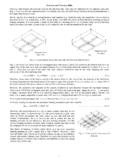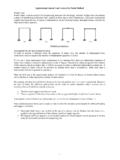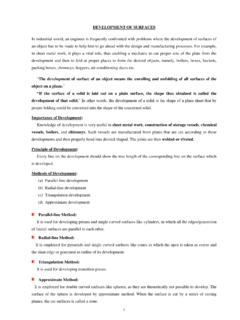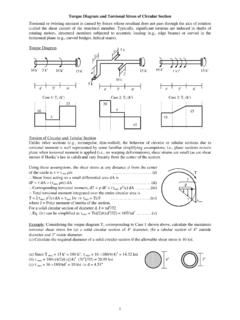Transcription of Design of Underground WaterTank - uap-bd.edu
1 Design of Underground water Tank (Reservoir) Tank Dimensions Total area for the four floors = 4 (16 14 14) (13 14 13) = 7040 ft2 Number of residents, N 7040 8/1000 = 56 Daily water requirement 56 5 = 280 ft3 Required volume of UG water tank, V = 2 280 = 560 ft3 Depth of tank, H V1/3 = (560)1/3 = Freeboard, = Total depth, D = H + = Assuming L/B = , Tank area A = LB 560 = B B = , L = Loads and Material Properties Loads: FF = 10 psf, LL = 20 psf Materials: fc = 3 ksi, ft,ult = 5fc = 5(3/1000) = ksi, ft,all = ft,ult/2 = ksi, fs = 20 ksi fc = = ksi, k = , j = , R = ksi, Rt = ft,all/6 = ksi For soil, Angle = 30 Ka = (1 sin )/(1 + sin ) = Design Conditions The UG water tank has three basic components.
2 , top slab, sidewalls and base slab The top slab will be designed as normal simply supported slab based on the self-weight and superimposed loads The Design of sidewalls and the base slab will be based on assuming (i) Tank full of water but no soil outside, (ii) No water inside tank but soil pressure from outside The other more critical condition of no water inside but saturated soil outside is avoided here because it might cause instability of the tank itself. Alternately, a provision must be made that the tank cannot be evacuated when the soil is fully saturated. Design of Top Slab This is designed as a simply supported slab with clear spans Sa = , Sb = , m = = Required slab thickness considering deflection = 2 ( + )/15 = Assuming minimum slab thickness t = 4, wTotal = 4 150/12 + 10 + 20 = 80 psf = ksf Ca = Ma(+) = ( )2 = k/ and Cb = Mb(+) = ( )2 = k/ d(req) = (M(max)/Rb) = ( ) = d = 3 or , OK Asa(+) = Ma(+)/fsjd = 12/(20 3) = in2/ Asb(+) = Mb(+)/fsjd = 12/(20 ) = in2/ As(Temp) = t = 4 = in2/, S(max)
3 = 2t = 8 Use #3 @ 8c/c in both directions (A): # 3 @ 8 c/c, alt. ckd. + 1 #3 extra top (B): Corner reinforcement # 3 @ 8 c/c in both directions 4 thick Top Slab A B Design of Sidewalls Since both L/H and B/H are within and , both the sidewalls have both slab and cantilever action. Cantilever action is within the bottom H/4 or 1 m height (whichever is greater). H/4 = = , while 1 m = Slab Action: Case (i) Tank full of water but no soil outside In this case, pmax = w (Hh) = ( ) = ksf Case (ii) No water inside tank but soil pressure from outside In this case, pmax = Ka s (Dh) = ( ) = ksf The following bending moments (k/) are obtained by analyzing the structure in GRASP Case (i) Case (ii) Cantilever Action.
4 Case (i) Tank full of water but no soil outside In this case, pmax = wH= = ksf The maximum bending moment Mmax = pmax h2/6 = = k/ Case (ii) No water inside tank but soil pressure from outside In this case, pmax = Ka sD = = ksf The maximum bending moment Mmax = pmax h2/6 = = k/ t(req) = (M(max)/Rtb) = ( ) = t = ; , d = 8 As = M/fsjd = M 12/(20 8) = in2/ As(Temp) = t = = in2/, S(max) = 2t = 19 Since M(max) = k/ As(max) = = in2/ As(Temp) governs in all cases; , Use #3 @ c/c on all surfaces in all directions (A): # 3 @ c/c, on both faces and in both directions of the slab (B): # 3 @ c/c, on both faces and in both directions of the slab thick Sidewalls A B Design of Base Slab Like the top slab, the base slab is also designed as a simply supported slab with clear spans However, the slab has to carry end moments ( k/ and k/) from the cantilever action of the sidewalls; which results in reduction of the midspan maximum moments.
5 Sa = , Sb = , m = = , t(req) = 2 ( + )/15 = However since the slab carries significant load from water , the assumed slab thickness t = 7 Case (i) Tank full of water but no soil outside wTotal = ct + FF + wH = 150 7/12 + 10 + = psf = ksf Assuming negative moment of k/ Ca = Ma(+) = ( )2 = k/ and Cb = Mb(+) = ( )2 = k/ Case (ii) No water inside tank but soil pressure from outside In this case, the total weight of top slab and sidewalls = {( + 19/12) ( + 19/12) 4/12 + 2 ( + + 19/12) } = k Net upward pressure from soil, wTotal = {( + 19/12) ( + 19/12)} = ksf Assuming negative moment of k/ Ma(+) = ( )2 = k/ Mb(+) = ( )2 = k/ t(req) = (M(max)/Rtb) = ( ) = t = 7, OK t = 7 d = = M/fsjd = M 12/(20 ) = in2/ As(Temp) = t = 7 = in2/, S(max) = 2t = 14 Since M(max) = k/ As(max) = = in2/ As(Temp) governs in all cases; , since the sidewalls require #3 rods @ c/c Use #3 @ c/c on all surfaces in all directions (A): # 3 @ c/c, alt.
6 Ckd. + 1 #3 extra top (B): Corner reinforcement # 3 @ c/c in both directions 7 thick Base Slab B A










